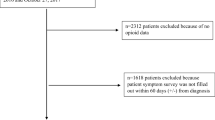Abstract
Introduction and hypothesis
The opioid epidemic is a recent focus of national initiatives to reduce opioid misuse and related addiction. As interstitial cystitis (IC) is a chronic pain state at risk for narcotic use, we sought to assess opioid prescription use in patients with IC.
Methods
Data were accessed from the Virginia All Payers Claims Database. We identified female patients diagnosed with IC from 2011 to 2016 using International Classification of Disease codes. A patient identifier was used to link diagnoses with outpatient prescription claims for opioids using generic product identifiers. We then analyzed opioid prescriptions within 30 days of a claim with a diagnosis of IC.
Results
A total of 6,884 patients with an IC diagnosis were identified. The median number of IC claims per patient was 2 (IQR 1 to 4). Mean patient age was 47.8. Twenty-eight percent of patients received at least 1 opioid prescription, with a median of 2 (IQR 1, 4) per patient. Among those receiving opioids, 185 (9.5%) had more than 10 opioid prescriptions, with a maximum of 129. The most common prescriptions were hydrocodone (n = 2,641, 32.3%), oxycodone (n = 2,545, 31.2%), and tramadol (n = 1,195, 14.6%). There was a decline in opioid prescriptions per month for IC, although the rate per IC diagnosis remained stable.
Conclusions
A significant number of patients with IC are treated with opioids. Although the overall number of opioid prescriptions associated with IC had declined, the prescription rate per IC diagnosis had not. As part of the national initiative to reduce opioid use, our data suggest that IC treatment strategies should be examined.




Similar content being viewed by others
References
Department of Health and Human Sources HHS Acting Secretary Declares Public Health Emergency to Address National Opioid Crisis. 2017. https://www.hhs.gov/about/news/2017/10/26/hhs-acting-secretary-declares-public-health-emergency-address-national-opioid-crisis.html. Accessed 8 May 2019.
Breivik H, Collett B, Ventafridda V, et al. Survey of chronic pain in Europe: prevalence, impact on daily life, and treatment. Eur J Pain. 2006;10:287–333. https://doi.org/10.1016/j.ejpain.2005.06.009.
Dembe A, Wickizer T, Sieck C, et al. Opioid use and dosing in the workers’ compensation setting. A comparative review and new data from Ohio. Am J Ind Med. 2012;55:313–24. https://doi.org/10.1002/ajim.21021.
Hanno PM, Erickson D, Moldwin R, Faraday MM. Diagnosis and treatment of interstitial cystitis/bladder pain syndrome: AUA guideline amendment. J Urol. 2015;193:1545–53. https://doi.org/10.1016/j.juro.2015.01.086.
McGovern FJ, Lieberman GM, Xu R, Anderson TA. The opioid epidemic: urology’s role in solving the crisis. AUA Update Series. 2018;37:337–50.
IC Association. 4 to 12 million may have IC. IC Association. 2015. https://www.ichelp.org/about-ic/what-is-interstitial-cystitis/4-to-12-million-may-have-ic/. Accessed 8 May 2019.
Clemens JQ, Mullins C, Kusek JW, et al. The MAPP research network: a novel study of urologic chronic pelvic pain syndromes. BMC Urol. 2014;14:57. https://doi.org/10.1186/1471-2490-14-57.
Nickel JC. Opioids for chronic prostatitis and interstitial cystitis: lessons learned from the 11th World Congress on Pain. Urology. 2006;68:697–701. https://doi.org/10.1016/j.urology.2006.04.013.
Tirlapur S, Birch J, Carberry C, et al. Management of bladder pain syndrome. BJOG. 2016;124:e46–72. https://doi.org/10.1111/1471-0528.14310.
Lai HH, Vetter J, Song J, et al. Management of symptom flares and patient-reported flare triggers in interstitial cystitis/bladder pain syndrome (IC/BPS)—findings from one site of the MAPP research network. Urology. 2019;126:24–33. https://doi.org/10.1016/j.urology.2019.01.012.
Koslov DS, Vilson F, Colaco M, et al. Impact of cystectomy with urinary diversion upon tracked receipt of opioid prescriptions among patients with interstitial cystitis/bladder pain syndrome. Urology. 2018;114:83–6. https://doi.org/10.1016/j.urology.2017.11.009.
Madsen AM, Stark LM, Has P, et al. Opioid knowledge and prescribing practices among obstetrician-gynecologists. Obstet Gynecol. 2018;131:150–7. https://doi.org/10.1097/AOG.0000000000002407.
Cichowski SB, Rogers RG, Komesu Y, et al. A 10-yr analysis of chronic pelvic pain and chronic opioid therapy in the women veteran population. Mil Med. 2018;183:e635–40. https://doi.org/10.1093/milmed/usy114.
Dowell D, Haegerich TM, Chou R. CDC guideline for prescribing opioids for chronic pain—United States, 2016.[erratum appears in MMWR Recomm Rep. 2016;65(11):295]. Morb Mortal Wkly Rep Recomm Rep. 2016;65:1–49. https://doi.org/10.15585/mmwr.rr6501e1.
Wickramatilake S, Zur J, Mulvaney-Day N, et al. How states are tackling the opioid crisis. Public Health Rep. 2017;132:171–9. https://doi.org/10.1177/0033354916688206.
AUA Position Statement: Opioid Use. https://www.auanet.org/guidelines/opioid-use. Accessed 5 July 2019.
Theisen KM, Myrga JM, Hale N, et al. Excessive opioid prescribing after major urologic procedures. Urology. 2018;123:101–7. https://doi.org/10.1016/j.urology.2018.06.057.
Shah AS, Blackwell RH, Kuo PC, Gupta GN. Rates and risk factors for opioid dependence and overdose after urological surgery. J Urol. 2017;198:1130–6. https://doi.org/10.1016/j.juro.2017.05.037.
Busse JW, Wang L, Kamaleldin M, et al. Opioids for chronic noncancer pain: a systematic review and meta-analysis. JAMA. 2018;320:2448–60. https://doi.org/10.1001/jama.2018.18472.
Gupta P, Gaines N, Sirls LT, Peters KM. A multidisciplinary approach to the evaluation and management of interstitial cystitis/bladder pain syndrome: an ideal model of care. Transl Androl Urol. 2015;4:611–9. https://doi.org/10.3978/j.issn.2223-4683.2015.10.10.
Centers for Disease Control and Prevention. U.S. Opioid Prescribing Rate Maps. 2018. https://www.cdc.gov/drugoverdose/maps/rxrate-maps.html. Accessed 8 May 2019.
Van Amsterdam J, van den Brink W. The misuse of prescription opioids: a threat for Europe? Curr Drug Abuse Rev. 2015;8:3–14. https://doi.org/10.2174/187447370801150611184218.
Kalkman GA, Kramers C, van Dongen RT, et al. Trends in use and misuse of opioids in the Netherlands: a retrospective, multi-source database study. Lancet Public Health. 2019;4:e498–505. https://doi.org/10.1016/S2468-2667(19)30128-8.
Rodríguez MÁB, Afari N, Buchwald DS. Evidence for overlap between urological and nonurological unexplained clinical conditions. J Urol. 2009;182:2123–31. https://doi.org/10.1016/j.juro.2009.07.036.
Author information
Authors and Affiliations
Contributions
JZ: project development, data analysis, manuscript writing; MBC: project development, data analysis and collection, manuscript writing; CWP: project development, data analysis and collection, manuscript editing; DER: project development, data analysis, manuscript writing/editing.
Corresponding author
Ethics declarations
Conflicts of interest
None.
Additional information
Publisher’s note
Springer Nature remains neutral with regard to jurisdictional claims in published maps and institutional affiliations.
Rights and permissions
About this article
Cite this article
Zillioux, J., Clements, M., Pike, C.W. et al. Opioid prescription use in patients with interstitial cystitis. Int Urogynecol J 31, 1215–1220 (2020). https://doi.org/10.1007/s00192-019-04214-2
Received:
Accepted:
Published:
Issue Date:
DOI: https://doi.org/10.1007/s00192-019-04214-2




